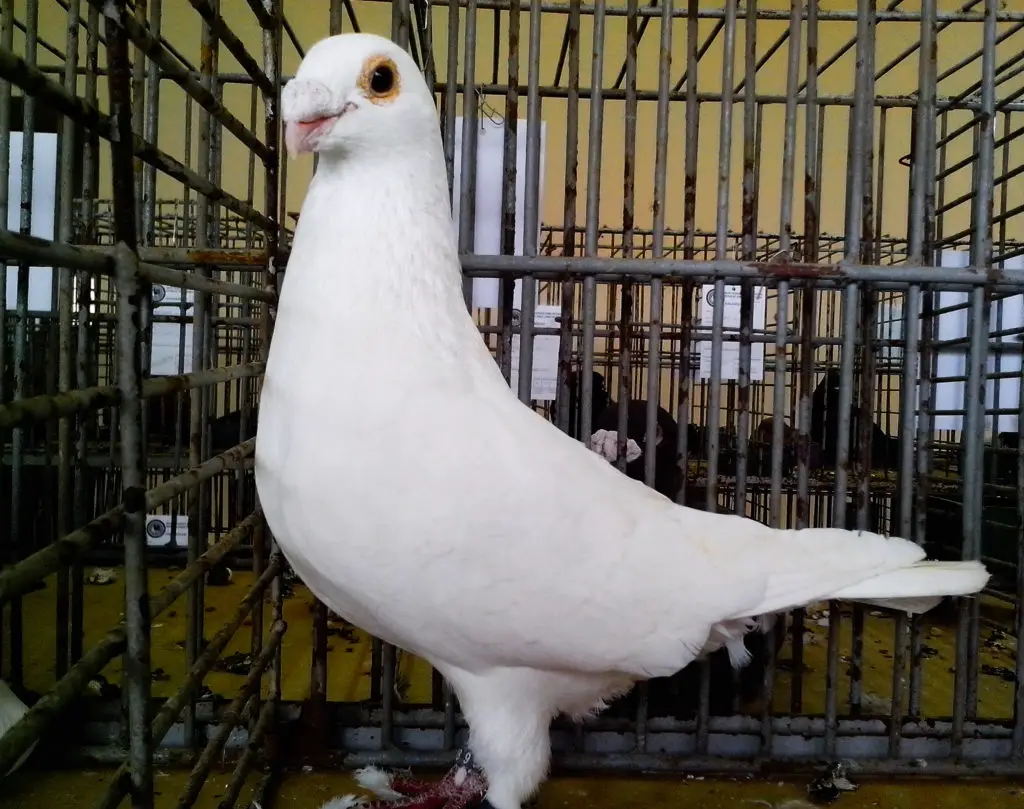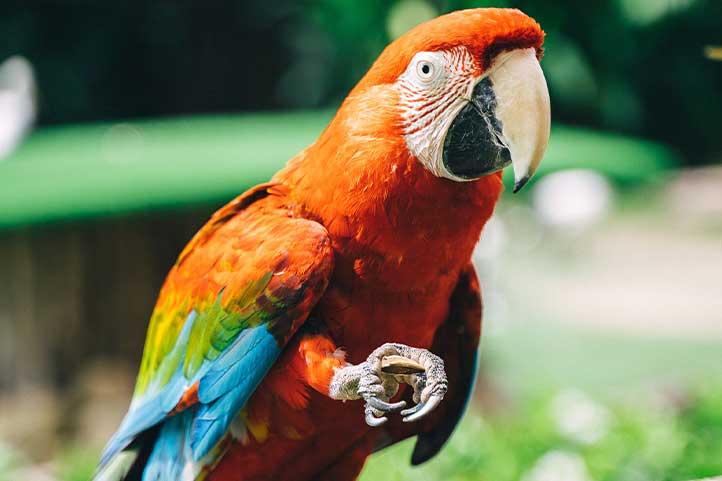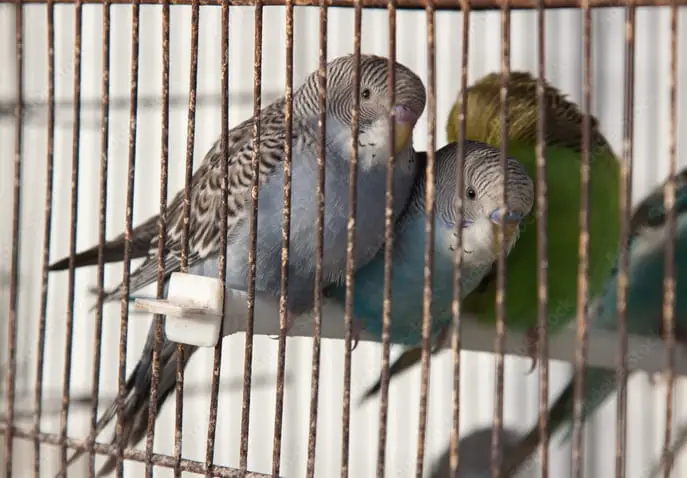Translated by Nick R
The pigeon turned out to be a very significant species for us for millennia, perhaps, more evident in cities now; especially when we are in the street and recall parks or town squares. But would they make good pets?
Table of Contents
Would a pigeon be a good pet?
Absolutely, a great pet. Pigeons are very interesting birds and there is nothing that would stop you from adopting one; there is no legal or environmental restriction that prohibits you from doing so. You simply have to take good care of them like any other pet, with its own particularities, of course. Taking care of a pigeon requires a lot of love and the will to offer them the very best life possible, the rest will be basic care, which I will show you here.
Normally, not much is said about pigeons as pets or companion animals, mainly because we get used to seeing them everywhere as opportunistic and stray animals or, just as part of the urban landscape; even though they were first used as messengers and have a great history by our side. They are also used in magic shows and as a symbol (white doves symbolize peace).
Though pigeons are considered invasive species, harmful, and a sanitary hazard in many parts of the world, given the overpopulation in cities; as pets would be a different story. In great part, the unpleasant behavior of these birds is due to the conditions to which they have been subjected by humans in large cities. However, a home with excellent conditions and the love of a responsible owner would be a great opportunity to rescue one or several pigeons.
Origin of pigeons
Pigeons are part of the Columbidae, along with turtledoves. Specifically, pigeons are found within the subfamily Columbinae and consist of all species within the genus Columba or commonly known as typical pigeons (not including the pigeons native to the Americas, which belong to the genus Patagioenas).
A great variety of species (more than 300) belong to the phylogenetic group Columba, of which some have been distributed all over the world, as is the case of the feral pigeon (Columba livia), a species from which the domestic pigeon (Columba livia domestica) descends and is recognized for its work as a messenger, among other uses.
Why adopt a pigeon?
Pigeons (referring to the domestic version of the rock pigeon) have many qualities compatible with what would be the characteristics of a good pet; in fact, with several advantages over the more common species. Therefore, chances are good that you’ll want to adopt one or more after you read this article.
5 reasons to adopt a pigeon
- They are intelligent and learn almost anything. So, if you want to teach them tricks, they can learn at great speed and their training will be very easy.
- They are sociable and affable, showing a predisposition to interact with people. Pigeons have been domesticated for a long time.
- They are independent birds, so you won’t have to look after them all the time. Give them space.
- They are highly adaptable, can live in almost any environment, and adapt quickly.
- If you wish to have more pigeons, they are inexpensive pets and easy to breed.
Characteristics and behavior of pigeons
| Scientific name | Columba livia domestica |
| Common name | Pigeon |
| Place of origin | Eurasia and Africa |
| Habitat | Any |
| Size | 29 – 37cm |
| Weight | 240 – 400 gr |
| Average sexual or reproductive age | 6 months |
| Life expectancy in captivity | Up to 30 years. |
Pigeons have a wide distribution, either as a natural species or introduced by man, due to their great aeronautical skills and excellent vision. These birds can be found all over the world (except Antarctica and the Arctic), originating in Eurasia and Africa.
The Rock Pigeon, which is the top of the group, has been introduced to other parts of the world. So, in America, you can find the same pigeons as in Europe. The domestic pigeon can be found today on all continents, including America, where they have been introduced since the 16th century.
Appearance
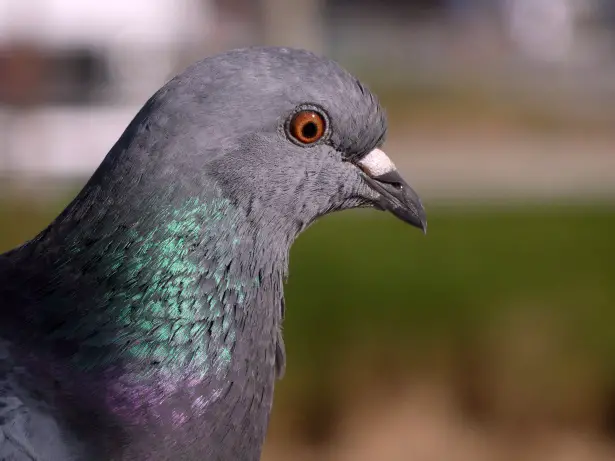
Pigeons are medium-sized birds, between 29 and 37 centimeters and weighing approximately 240 to 400 grams. Physically, they are easily recognized by their rounded body, robust chest, small head, and relatively short legs. The common pigeon has a gray plumage with black streaks on the wings, the head and neck are a little darker than the rest of the body and exhibit an iridescent luster; they have a blackish beak with whitish wax, reddish or pinkish legs and amber eyes.
Obviously, domestication brought variety in the characteristics of the common pigeon. Thus, the domesticated subspecies have a wide variety of colors and you will see white, brown, gray, black, and other more creative colors. Currently, there are 150 known breeds of pigeons around the world.
Pigeons are monomorphic which means that there is no physical difference between females and males that can easily distinguish them.
Wild behavior
For you to understand how they behave in their natural habitat, the pigeon in the wild (feral pigeon) will be our model. Wild pigeons are organized in large social groups called flocks, where individuals work together to travel and forage for food. A peculiarity of these groups is that in the air they form a V-shape.
Pigeons resemble biological compasses because they have an impressive sense of direction, which, coupled with their super vision, makes them unique animals. Long ago, when they were used as homing pigeons, it became evident that they have the ability to find their way around and return home without any problem. This route-finding ability has been the subject of studies and speculation, including one that suggests that the accumulation of iron in their beaks is used to detect the earth’s magnetic field.
Pigeons reach sexual maturity at about 5 to 6 months, when they begin to reproduce, which they do until they are 10 years old. This is the only time in which they are not gregarious, but are organized in pairs, male and female, who will remain “married” forever. That is, they are monogamous birds.
The male conquers the female by puffing out his chest and walking in a circle around the female, making movements with his head. Once the first chicks mature and are completely independent, the parents are ready to procreate two more chicks. The pigeons build simple nests from a small, well-hidden twig lattice of twigs under the care of the mother.
Domestic behavior
Regarding behavior in captivity, the domestic pigeon is our model. Although it has many similarities with its wild ancestor, the Columba livia domestica has its own peculiarities.
Pigeons are very intelligent
In fact, they are far more intelligent birds than was previously thought of small bird species. Just as crows are renowned for their keen intelligence, problem-solving, and tool-making, pigeons have a great ability to learn and recognize colors in an absurdly accurate manner.
As explained by experimental psychology professor Edward Wasserman, these birds can distinguish space and time, an ability analogous to primates that suggests abstract thinking – impressive! In addition, Professor Wasserman indicated that pigeons can remember more than 1800 images.
You may also be interested in What are the most intelligent birds?
Pigeons are sociable
If you have a pigeon, you need plenty more. These birds are gregarious and prefer to be in company. Additionally, they are very faithful and when they find mates, they keep them forever. In captivity, I recommend that you group a maximum of six individuals per cage so that they don’t feel lonely. In general, they are very quiet birds and don’t dislike the presence of other birds or people.
They are also a bit sedentary
Domestic pigeons can travel more than 700 miles to other places, but unlike wild pigeons, they are more sedentary. For most of their life cycle, they stay in the same region, without moving far from it. This explains why they adapt so easily to life in captivity.
Construction is not their profession
Pigeons are not known for being the best nest builders, quite the contrary. Therefore, you don’t need to be too concerned about where they are going to lay their eggs, they solve it in a practical way. Unlike other species, pigeons don’t frequent trees, they prefer cliffs and high areas such as poles and buildings because their legs don’t allow them to stand on branches.
They are a symbol of freedom
Pigeons are very active and restless, so they like freedom. That is a challenge when they live in captivity, so if you don’t have the space and conditions to keep them free, you better not even have one; no matter how many white pigeons you have, you won’t have peace.
Ideal housing and space for pigeons
Space for birds is very important, pigeons are no exception and must have a large place that gives them great freedom. Both inside and outside the cage, they should have the possibility to play. Obviously, the cage, as I always say, should have more of the function of an alcove than a house. You know that pigeons are very active birds and capable of flying long distances, so they must have a place that allows them to emulate their natural habits.
Keep the room temperature between 22 and 25°C in the mornings and between 16 and 20°C at night (use a blanket to cover them), pigeons prefer warm and temperate places.
Cage for pigeons
If you want to enjoy their company permanently and create a close bond with these birds, you must adjust a cage to shelter and keep your winged friends safe. I recommend adapting or building an aviary for pigeons near a light source that offers space and good temperature. In this case, ensure several hours of the day for recreation, allowing them to leave the cage.
You can also raise them freely, adapting an outdoor enclosure for the pigeons to arrive, eat and rest for a while. This way you don’t need to keep them permanently captive and still enjoy their company.
The space, as far as possible, should be exclusively for them, as their life can be endangered by predators (including other pets).
Dovecote
It is a structure destined exclusively for pigeons and chicks that allows them to fly and interact in a unique space. It’s very useful when you dispose of a country area where you can adapt it without any problem and with a bigger size.
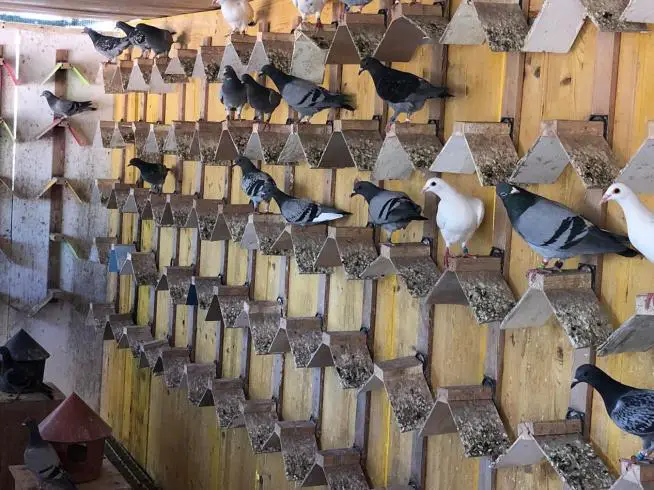
Hygiene and cleanliness of pigeons
Bath
As in the rest of the birds, bathing pigeons is fundamental and non-negotiable; their feathers need to be clean to function well and avoid diseases. Of course, not every day, but periodically. Remember that bathing is one of the pillars of pet bird care. Bathing can be scheduled once a week, leaving a bathing place available for the animal to bathe.
Cleaning
Pigeons can be housed in very large spaces and live with many specimens at the same time. However, the cleanliness of this place and all the places frequented by the bird is fundamental to basic care. The proliferation of harmful microorganisms can be avoided by cleaning their space, in addition to changing the drinking and feeding bowls daily.
Feeding of pigeons
They can be classified as granivorous and frugivorous birds, they like to forage on the ground for berries. However, due to their great ability to adapt to almost any environment and find new food sources, pigeons are great survivors and can feed on human food, with flocks of pigeons evident in cities around restaurants and food courts. In fact, they can be seen eating waste in the garbage.
And as pets, what do pigeons eat?
Necessary food
Pigeons require a rich source of protein and vitamins to stay healthy, so their diet must be diverse. Pigeons, as I said, like seeds and fruits.
Seeds
As granivorous birds, pigeons need a large amount of seeds in their diet, so they need to consume approximately 50% of dry food such as seed mixtures and special food for pigeons, which contain enough protein, fiber and other basic nutrients. However, I don’t suggest that you only feed them seeds, but vary their diet with other foods.
Fruits and vegetables
These birds like fresh foods such as fruits and vegetables, which complement their seed-based diet and make up 40-45% of their diet. These are the most recommended fruits and vegetables for pigeons:
- Apple.
- Banana.
- Lettuce.
- Mango.
- Corn.
- Strawberries.
- Tomato.
- Spinach.
- Carrot.
- Pear.
- Papaya
- Cucumber.
Others
The other 5-10% of their diet should be supplemented with food such as pellets and live animals such as worms and insects (optional), and occasionally give them eggs, which will provide a little more protein (animal).
Don’t forget the water, they must always have water available in their drinking troughs. Pigeons should consume about 15% of their body weight daily.
Forbidden foods
In spite of what you may think about the nutrition of these birds because of their great capacity to adapt and to eat human waste, pigeons cannot eat some foods, which are strictly forbidden:
- Industrialized human food.
- Chocolate or sugary foods or drinks.
- Avocado.
- Onions.
- Garlic.
- Salty foods.
- coffee
- Sweets.
It is always advisable to consult with a veterinarian about your bird’s diet.
Pigeon Health
Pigeons are very hardy animals in general terms, but here are the five most common diseases they can suffer from.
| Health problems | Symptoms and cause | What to do? |
| Stress | One of the most common diseases of pigeons results from lack of activity and confinement. The nervous system of pigeons is very sensitive and they are prone to suffer from nervous breakdowns that can be irreversible, affecting them permanently. | Provide ample space and sufficient recreational hours to exercise the bird. The most important recommendation for a happy and strong bird is to constantly monitor its health. |
| Trichomoniasis | It is a disease caused by protozoan Trichoma, causing diarrhea, intense thirst, weight loss, and difficulty breathing. Pigeons acquire it after drinking contaminated water. It can cause death in birds with low defense. | It’s very important to keep its environment clean; change water and food every day. On the other hand, taking into account that most pigeons live with this parasite without suffering any damage, you have to keep the bird’s defenses strong. Take it to the veterinarian. |
| Paramyxovirus | Paramyxovirus can be fatal. This is a lethal disease that causes uncoordinated movements, diarrhea, convulsions, loss of balance, and difficulty walking. It is transmitted by direct contact with infected birds. | Cleanliness is again the protagonist, as it happens in trichomoniasis. Both the pigeon and the places it frequents must undergo a strict cleaning periodically. Take the pigeon to the veterinarian. |
| Salmonellosis | It’s a disease that affects both pigeons and humans, caused by the bacterium of the genus Salmonella Sp. Young pigeons are more prone to contract salmonellosis by direct contact with sick birds. Symptoms include diarrhea, paralysis, weight loss, generalized weakness, and loss of balance. | Here regular check-ups of individuals and general cleanliness play an important role. Salmonellosis is a very common and easily acquired disease, which can lead to death if not taken care of. It is advisable to take the pigeon to the veterinarian. |
| Coryza | Coryza is a disease caused by Avibacterium, which proliferates mostly at certain times of the year under certain climatic conditions, causing sneezing, difficulty in breathing, nasal effusions, and ocular swelling. It is a dangerous disease since it can be asymptomatic, affecting apparently healthy birds. | It’s important to keep pigeons away from drafts and cold. Remember that the body temperature of birds is high. If you notice any pigeon with symptoms, discuss it with your veterinarian. |
Is it true that pigeons carry diseases?
Zoonosis from pigeons to humans
Something you must keep in mind when keeping pigeons as pets is that, although they don’t represent a great risk to humans, they can transmit diseases to us. It doesn’t only happen with pigeons, it can happen with other species for x or y reasons. Here are some of these zoonotic diseases:
Cryptococcosis
Caused by the fungus Cryptococcus neoformans, which is found in pigeon droppings and can be transmitted to humans by inhalation. Dried pigeon droppings give off the dust, where the fungus lodges, and when it enters the respiratory tract, it infects the lungs.
Chlamydiosis
Chlamydiosis is caused by the bacterium Chlamydia psittaci and pigeons transmit it to humans through feces or handling infected birds, affecting the respiratory tract and then the bloodstream.
Histoplasmosis
It’s a zoonotic disease caused by the fungus Histoplasmosis capsulatum present in pigeon feces that can be inhaled by humans.
Recommendation: Check vaccinations with your veterinarian.
6 facts you didn’t know about pigeons
Pigeons produce milk
Pigeons, unlike other species of birds, don’t need food for their chicks, they produce milk (not exactly), a natural food produced in the crop of the father and the mother; something like what happens in mammals, but with the difference that pigeon’s milk doesn’t contain sugars (carbohydrates). The crop milk is a substance secreted by the parents to feed their chicks, which contains 60% protein and 40 % lipids (fats).
Pigeons drink and drink…
They have the ability to drink water uninterruptedly since, instead of drinking water, they suck it up. Birds usually need to move their heads upwards to swallow the water they drink, pigeons don’t. They are thirsty birds that live thirsty all the time as they can survive several days without eating solid food, whereas, they must drink water every day.
Pigeons against the cold…
When pigeons feel very cold, they fluff their feathers to keep warm. If you have seen pigeons fluffing (balling up), it is due to this behavior. Pigeons, as well as birds in general, maintain a high body temperature to ensure that the body functions properly through natural thermoregulatory mechanisms.
Pigeons go straight to the sky
Pigeons are the only birds that can fly straight up, capable of flying at high speed vertically into the sky like a rocket. In general, birds that swoop and reach high speeds are more common, yet pigeons are definitely out of this world.
The “fast and furious” pigeons
If you were impressed by the speed of cheetahs and birds of prey, pigeons are very fast birds as well, reaching over 100 km/h. On average they can fly at a speed of 80 km/h but can reach a maximum of 130 km/h.
Pigeons have two magnifying glasses
Pigeons have a far superior sense of sight in the animal kingdom, as powerful as that of birds of prey. Although their eyes are flat with an excellent monocular (granivorous) vision adapted for better panoramic images, these birds developed such acute eyesight that they can see beyond 26 miles away.
The eyes of pigeons are divided into two foci. On the one hand, the upper half deals with long distances. On the other hand, the lower half handles short distances or close-ups.
Don’t go away, I have one more piece of information for you…
Pigeons see farther
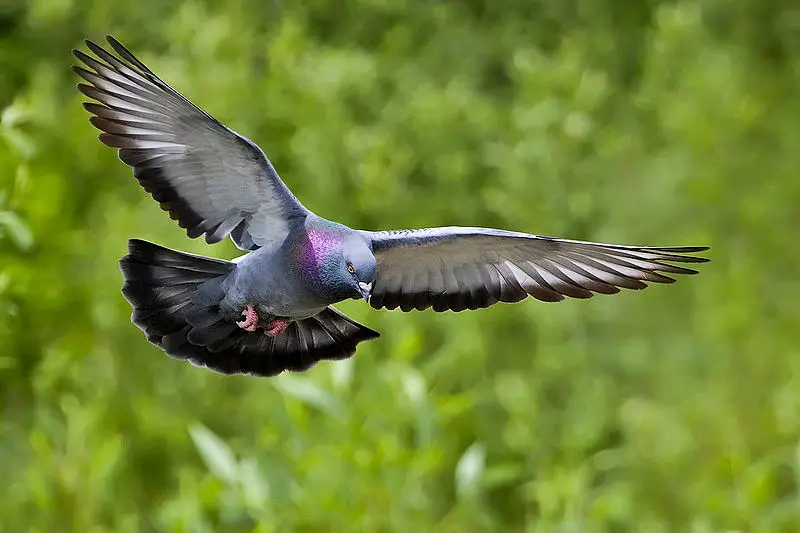
The vision of pigeons is impressive; they are able to see ultraviolet light. These birds can see a swath of the electromagnetic spectrum (light) that humans cannot see, perceiving beyond visible light and revealing secrets of the world beyond colors. Pigeons have the ability to see the three-dimensional structure of forest foliage.
Several experiments have highlighted the ability of these birds to see the world in a more advanced dimension than others. So unique is their visual ability that they have been used for both medicine and art. Pigeons can detect tumors and help in the prevention of cancer and distinguish paintings by great painters such as Monet, being able to differentiate between cubism and impressionism with ease, as if they were an expert.
If you don’t believe me, watch the video “Visual perception: Pigeons vs Humans”.
If you decided to have a pigeon as a pet, I congratulate you and remind you that they are already considered a problem in the streets, do not abandon them; better offer them a good home.
You may also be interested in:
